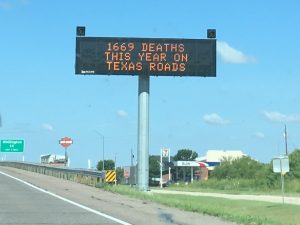
Recent research from UTTRI associated faculty Professor Jonathan D. Hall and Professor Joshua Madsen of the University of Minnesota reveals that highway dynamic message signs increase crashes.
Such highway signs are behavioural interventions, designed to encourage socially desirable behavior – in this case, driving more carefully. “They are expressly designed to seize people’s attention” however, “little consideration has been given to the costs of seizing attention,” researchers state in their paper “Can Behavioral Interventions Be Too Salient? Evidence From Traffic Safety Messages” posted online by SSRN July 15, 2020.

Featured in the Telegraph article “Digital road signs cause more crashes than they stop, warn economists” September 1, 2020, evidence from this research shows that the end result of such signs is contrary to their intention. According to the article:
They found that the number of crashes in the 10km (six miles) after the signs were up to 8% higher during the weeks that the messages were shown. The bigger the fatality number displayed and more complex the road network, the more accidents there were.
For the full details of the research, access Hall and Madsen’s paper online at SSRN: “Can Behavioral Interventions Be Too Salient? Evidence From Traffic Safety Messages.”
The September 1, 2020 Telegraph news article “Digital road signs cause more crashes than they stop, warn economists” is also available online (paywall).
Related content
- Presentation PDF “Can behavioral interventions be too salient? Evidence from traffic fatality messages,” Jonathan D. Hall, University of Toronto and Joshua Madsen, University of Minnesota, August 24, 2020
- Hall: How is ride-hailing changing cities?
- Video “How I Learned to Stop Worrying and Love Road Tolls,” Professor Jonathan Hall, Department of Economics, University of Toronto.
